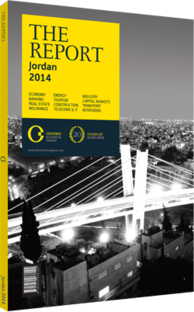Regional migration and macroeconomic growth support sales
The value of real estate transactions in 2013 stood at JD6.3bn ($8.9bn), up 15% in nominal terms from JD5.6bn ($7.91bn) in 2012. The sector’s rate of expansion was well above inflation of 5.5%, pointing to substantial real growth. The number of residential apartments sold in 2013 rose to 30,380 from 25,434 in 2012. Of these, 20,084 were 150 sq metres in size or smaller. However, the number of land sales fell, from 86,778 in 2012 to 68,201, likely as a result of rising land prices. January to April of 2014 saw even stronger growth in transactions, with the value of real estate sales rising to JD2.54bn ($3.59bn) from JD2.01bn ($2.84bn) in the same period of 2013. In the first four months of 2014 11,473 apartments were sold, up 24% on the first four months of the previous year, while the number of land sales increased 23% year-on-year to 22,525.
Recent growth partly reflects a return to form for the real estate market, following something of a slump in 2012, when trading levels fell 12.9%, from JD6.43bn ($9.08bn) in 2011. Overall macroeconomic growth is helping to drive activity in the sector; the IMF put growth in 2013 at 3.25% and forecast a rate of 3.5% in 2014, compared to 2.3-2.7% in the previous three years.
Growth areas include outer neighbourhoods of the capital Amman. “Residential space is becoming limited in Jabal Amman, for example, and Jordanians living closer to the centre are having to compromise on size,” Wael Al Jabaari, CEO of Abdoun Real Estate, told OBG. “However, the city is expanding, in particular towards the airport. That side of the city has become quite popular due to recently improved transport connections and the fact that land is cheaper, allowing people to more easily buy three-bedroom units.”
Home Loans
The sector has also been supported by a rise in home loans. The value of housing loans extended to individuals by banks stood at JD2.04bn ($2.88bn) in 2013, up from JD1.75bn ($2.47bn) the previous year and JD508m ($717.6m) in 2008, according to data from the Housing and Urban Development Corporation (HUDC). Of such loans in 2013, 61.5% were extended by commercial banks and 38.5% were from Islamic banks. Increased lending is partly a result of looser terms and rising confidence alongside wider fiscal policy. With the central bank cutting interest rates on deposits so more people are inclined to invest their money and many are no longer waiting.
In addition to improved confidence generally, Emad Kilani, CEO of Al Maabar Jordan, told OBG there are renewed signs of willingness to invest off-plan at the high end of the market, after perceptions of pre-sales took a hit following the 2008 economic crisis and the regional instability of recent years. “Credibility is a big issue in the Jordanian real estate market,” said Kilani.
Foreign Demand
Against a backdrop of overall growth, real estate sales to non-Jordanians fell to JD406.5m ($574.22m) in 2013 from JD429.6m ($606.85m) in 2012 and JD449.2m ($634.54m) in 2011. The largest foreign purchasers of foreign real estate by far are Iraqis, whose combined real estate acquisitions totalled JD205m ($289.53m) in 2013, followed by Saudis with JD59m ($83.34m) and Syrians with JD24m ($33.90m). The effect of conflict on real estate sales has been mitigated by the fact that most Syrian refugees are far from wealthy, unlike many Iraqis.
“Iraqis bought, whereas Syrians mostly rent,” said Mai Asfour, senior director of housing policies at HUDC, adding that the arrival of large numbers of refugees have pushed rents up by around 200% in some parts of northern Jordan. “In the lower end of the market, Syrians are helping to drive demand, especially outside of Amman; however, unlike the case of Iraqi refugees, Syrians haven’t really affected the higher end of the market,” Al Jabaari told OBG.
Commercial Potential
Developers are hoping that regional political and security trends and the redevelopment of Amman will together help drive further growth in the commercial segment by persuading foreign firms to relocate to the kingdom, using it as their base for the Levant. In fact, some regional banks are already moving their headquarters to the capital city.
You have reached the limit of premium articles you can view for free.
Choose from the options below to purchase print or digital editions of our Reports. You can also purchase a website subscription giving you unlimited access to all of our Reports online for 12 months.
If you have already purchased this Report or have a website subscription, please login to continue.

